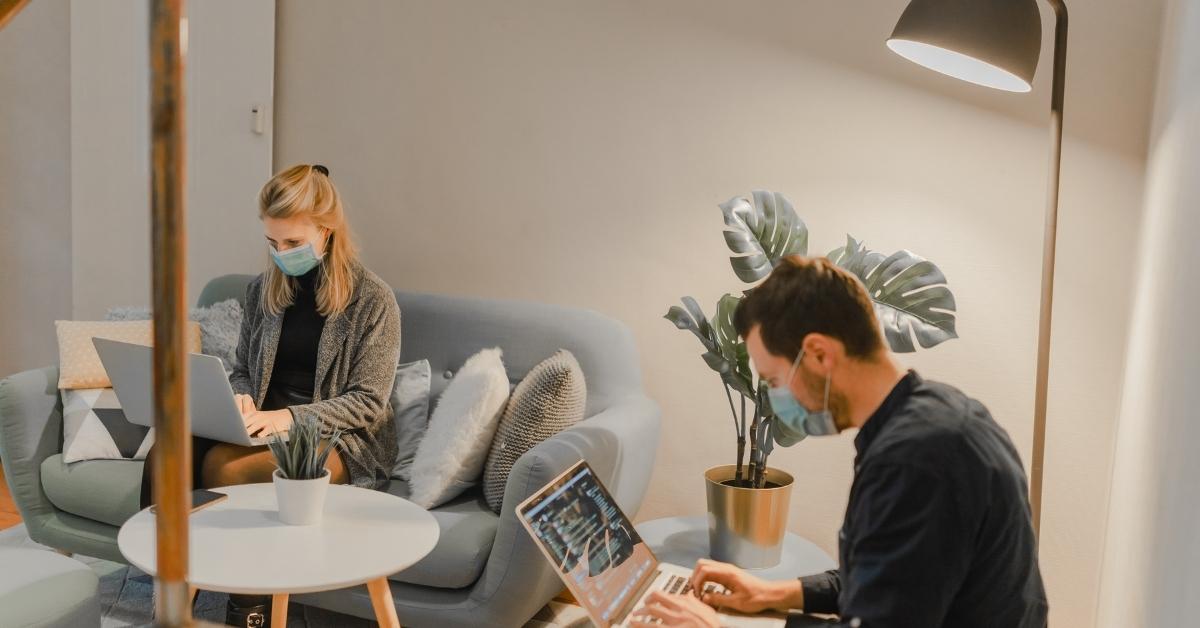Influence of Air Quality on Virus Transmission

In busy indoor areas with poor air quality, the risk of infection by viruses and bacterial germs is particularly high. Hence the urgent current recommendations for frequent ventilation: After all, air transmission plays a major role in COVID. What exactly lies behind this postulate in terms of findings and what those responsible for home office returnees can do in concrete terms is the subject of this article.
There's Something in the Air: the Connection between Air Quality, Aerosols, CO2, and COVID
Let's start putting the cart before the horse. Airborne transmission is a crucial, if not the main, route of transmission of the SARS-CoV-2 coronavirus in COVID, as we now know.
In the infectious phase, just before the onset of any symptoms, the virus, which is about 0.14 micrometers small, transmits silently but powerfully, namely via the approximately 10 liters of air breathed per minute by adults
Every time we exhale, we emit small aerosol particles: invisible floating aqueous micro-droplets, smaller than 5 micrometers - and in the case of an infected person, loaded with viruses
These spread in the room air like steam or smoke until they evaporate or settle. The virus remains active for 3 to 5 hours. A closed room thus fills up over time with increasing viral load and growing risk of virus transmission. A current study from Berlin confirms this. Remedy creates primarily an efficient air exchange, consistent airing with fresh air from outside. The researchers from TU Berlin also proved this under defined conditions and by means of elaborate measurement technology.
So What Does Indoor Air Quality Say About the Risk of Virus Transmission?
In particular, the airborne transmission of COVID? We spend 9 out of 10 years of our lives indoors – constantly exhaling carbon dioxide, water, odors and microbes, the aforementioned aerosols, and sweating to boot.
Good indoor air, on the other hand, contains the lowest possible concentrations of such impurities and, of course, of other pollutants such as volatile organic compounds (VOCs). It smells fresh and has a pleasant temperature. Carbon dioxide, CO2, is the keyword here.
Where is good Air? CO2 is a Reliable Indicator of Quality
Max von Pettenkofer already stated more than 150 years ago:
The CO2 content is an ideal indicator of the air quality of premises.
Outdoor air contains around 400 ppm (parts per million, i.e. 0.04 percent) of carbon dioxide, while indoor air contains considerably more after only a short stay. Ideal for health and performance are 600 ppm indoors. Even at a high air quality of 800 ppm, one percent of the air you inhale comes from the breath of the other people in the room! 1000 ppm is the "Pettenkofer value", the usual guideline value for average air quality, the health limit is set at 1400 ppm. So much for the situation independent of pandemic times
The correlation between CO2 and COVID in rooms is currently becoming more and more important, we will come to that. Whether offices, production halls or workshops, canteens or meeting rooms: wherever people spend time, CO2, germs and VOCs run in tandem. CO2 is therefore a marker of air quality and a universal trigger for healthy ventilation.
CO2 Monitoring: the Guide to Air Improvement
The key question now is: How can companies determine the right frequency for ventilation with reasonable effort? At best, monitor and immediately take countermeasures when limit values are reached? When exactly does the risk become too high? After all, rooms are rarely rigid and uniformly occupied.
The idea of depositing commercially available CO2 measuring devices with an infrared measuring principle in rooms lulls one into a deceptive sense of security. They usually detect snapshots as individual values, are irritated by humidity and/or require regular calibration for accurate analyses. In short: they are not suitable for monitoring air quality.
In addition, CO2 is not the only relevant parameter in COVID and must be interpreted in context. High-quality indoor air quality measuring instruments therefore use sophisticated and reliable sensor technology and offer a lot more besides. Several arguments speak for their use.
Complex Events: Infection Risk and Air Quality are Interrelated
Employees come and go, are sometimes more, sometimes less breath active. When speaking quietly, calling or lecturing (3 to 4 times), singing or shouting (4 to 9 times), the quantity of their exhaled airborne particles increases massively. This can be illustrated by the level of the CO2 content in the room. The risk of infection, however, depends on many other factors, including room volume and number of people, duration of stay, and protective measures. Additional criteria are extremely difficult to assess, such as infectivity ("super-spreader") and which virus mutation is present. Also, the minimum virus number leading to infection, the "virus dose", has not yet been clarified. Information on risks is therefore only estimates based on evaluations and assumptions of previous courses and cases. However, they do provide useful information on individual risks or potential infection rates: See MPI Chemie's Risk Calculator.
From Home Office Back to the Office: Employee Concerns
As the person responsible for your company's employees, you're naturally concerned with making the work environment attractive, motivating and performant. Even beyond pandemic times, you want to ensure that your team's cognitive performance is enhanced, health is promoted and, ultimately, sick days are kept to a minimum
Modern company health management and health promotion are also a big plus from the employee's perspective and increase the employer ranking among prospective employees.
And currently? Home office has helped to overcome crisis peaks and waves of infection, and has accelerated digitalization worldwide. But it is not a panacea and cannot be a permanent solution in many places. Presence is unavoidable, at least in parts. On the other hand, countless people returning from their desks at home are worried: Will my risk of becoming infected increase dramatically? Could my job become a danger to my family? Is my employer doing enough to protect me, to protect us all? Show them.
Air Quality Monitoring as Part of the Protection Concept
According to the Labour Code plus the COVID-19 Ordinance, companies are obliged to take appropriate measures to protect all employees (cf . SECO leaflet).
This obligation provides for the combination of several precautions to form protection concepts that can be justified according to the situation. Home office is one of them.
Let us briefly recapitulate: the risk of infection via droplet infection (up to 0.1 millimetres in diameter) is reduced by a minimum distance of 1.5 metres, short contact times, face masks and partitions. These larger particles are produced by blowing the nose, coughing, sneezing and "moist pronunciation", follow a ballistic curve and sink quickly to the ground.
Disinfectants protect against smear or direct contact infections from contaminated surfaces.
The risk from potentially infectious aerosols can be reduced by continuous air exchange or frequent ventilation: Cross-ventilation or shock-ventilation every 60 minutes are frequent recommendations. Special (expensive) filter technologies also help in the fight against the growing viral load. Instead of general or emotionally controlled ventilation impulses, objective monitoring of the prevailing air quality would certainly be more efficient. Unhealthy carbon dioxide concentrations are simply perceived by people far too late
Our solution: Sensors continuously and wirelessly transmit real-time data to AIRICA, whose AI evaluates them meaningfully and delivers concrete announcements
As a very simple signal via AIRICA feedback devices in the room: Pause! Ventilate now! Supplemented by a central dashboard with air improvement suggestions and additional real-time room usage data including convenient managed service.
Additional Benefits of Controlled Air Quality: The Health Plus with Learning Factor
Put the air for living and working in the position it deserves. Professional Indoor Air Quality Monitoring will help the people in your company to pay attention to ventilation. Learning how to keep air conditions optimal for everyone and contagion risks minimal. Orient room assignments and meeting schedules to this as well. Use breaks consciously not only for socializing or drinking coffee, breaks are also air exchange times: Fresh rooms and airways, fresh ideas.
In a Nutshell
Air quality will move from the periphery of the field of vision to the focus of health management in the future. Performance and health in the workplace benefit immensely simply by proper, regular ventilation. The relationship between poor air quality – measured by peak concentrations of CO2 – and COVID via air transmission (aerosols) is evident.
CO2 monitoring with modern, intelligent systems provides clear, uncomplicated support in deciding when the risk of virus transmission increases excessively and air exchange becomes necessary. It can currently provide concrete support in increasing safety in operations. And it has the potential to prospectively become an important part of modern infrastructure, a visible proof of corporate health care.

